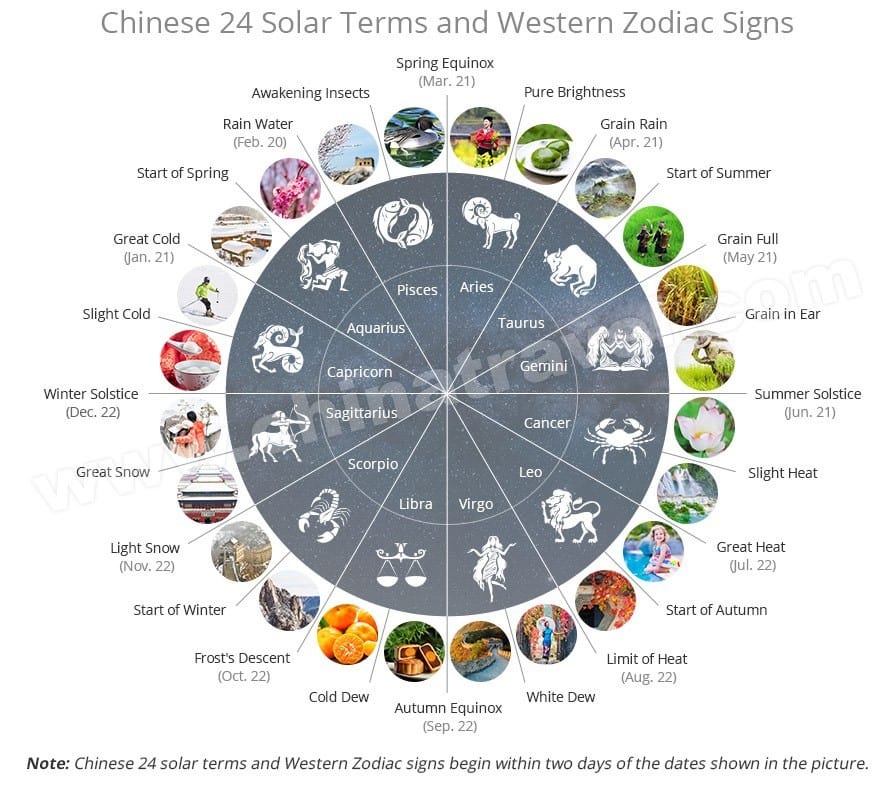
(Source: https://www.chinatravel.com/facts/chinese-solar-terms.htm)
After the “Cold Dew”, even Macau, which is located in the southern part of China, gradually cools down. Autumn is the season with the greatest climate change of the year. From “The Start of Autumn” to “Frost’s Descent”, the climate changes from hot to cold, from wet to dry, almost spanning the three seasons of summer, autumn and winter.
We have introduced the summer solar terms in July, and today, let us take a look at the autumn solar terms.

(Source: https://www.zcool.com.cn/work/ZMjQwOTkyMzI=.html)
立秋 (lì qiū) The Start of Autumn – August 6, 7, 8 or 9
At “The Start of Autumn”, the cool breeze begins to rise and the temperature begins to drop, indicating that the hot and difficult summer is about to pass. However, the drop in temperature is not noticeable, and most parts of East China are still in summer. Although this is “The Start of Autumn”, autumn has not yet arrived. As the twenty-four solar terms are equal in length in four seasons divided by astronomical methods, but not in meteorology, hence, “The Start of Spring” and “The Start of Autumn” happened at the end of winter and summer.
 (Source:https://www.zcool.com.cn/work/ZMjQwOTkyMzI=.html)
(Source:https://www.zcool.com.cn/work/ZMjQwOTkyMzI=.html)
處暑 (chù shǔ) The End of Heat – August 22, 23 or 24
處 (chù) is termination, which means that the hot summer is finally over. As soon as “The End of Heat” is over, the temperature in most parts of China begins to drop. Since “The End of Heat”, the frequency of north wind in northern China increases significantly, and the average temperature drops from 26.0°C during “The Start of Autumn” to 23.4°C. In addition, the north wind not only decreased the temperature, but also the humidity.
 (Source:https://www.zcool.com.cn/work/ZMjQwOTkyMzI=.html)
(Source:https://www.zcool.com.cn/work/ZMjQwOTkyMzI=.html)
白露 (bái lù) White Dew – September 7 or 8
“White Dew” is the solar term with the largest temperature difference between day and night throughout the year. Its arrival means that the weather is getting cold. People can feel that the hot summer is over and the cool autumn is arriving. In the early morning, many dewdrops will be found on leaves and on the ground turned white, which is why we call it “White Dew”. Starting from the “White Dew”, the temperature decreases sharply in the middle and lower reaches of the Yellow River in China.
 (Source:https://www.zcool.com.cn/work/ZMjQwOTkyMzI=.html)
(Source:https://www.zcool.com.cn/work/ZMjQwOTkyMzI=.html)
秋分 (qiū fēn) Autumn Equinox – September 22, 23 or 24
The length of day and night are equal on the “Autumn Equinox”, the weather is neither very cold nor very hot. The “Autumn Equinox” divides the autumn equally (the midpoint of between “The Start of Autumn” and “The Start of Winter”). In many places of China, there is a saying of “putting weight on in autumn” on the “Autumn Equinox”, which means that people need to gain more weight in the coming winter.
 (Source:https://www.zcool.com.cn/work/ZMjQwOTkyMzI=.html)
(Source:https://www.zcool.com.cn/work/ZMjQwOTkyMzI=.html)
寒露 (hán lù) Cold Dew – October 7, 8 or 9
“Cold Dew” is in the ninth month of the lunar calendar, the weather is colder than “White Dew”, and there is more dew than before. The white and crystal dew on the ground is about to condense into frost, and the chill is getting stronger, so it is called “Cold Dew”. “Cold Dew” also represents the arrival of late autumn, and the climate gradually changes from cool to cold and snowy.
 (Source:https://www.zcool.com.cn/work/ZMjQwOTkyMzI=.html)
(Source:https://www.zcool.com.cn/work/ZMjQwOTkyMzI=.html)
霜降 (shuāng jiàng) Frost’s Descent – October 23 or 24
降 (jiàng) means “coming”. After the frost came, the temperature dropped rapidly. The average temperature of this time in the middle and lower reaches of the Yellow River is only 11.4℃. In the early morning, temperature even drops to minus. The water drops on plant leaves are no longer dew but frozen into frost. In the latter part of “Frost’s Descent”, the middle and lower reaches of the Yellow River enter the real winter.
Related Videos:
[1]https://www.youtube.com/watch?v=gQTGEK5B80s&list=PLOHG5PB2LOchKtnoDjb_Yszmk9SOobL6O&index=15
[2]https://www.youtube.com/watch?v=Bp13KVOwZhM&list=PLOHG5PB2LOchKtnoDjb_Yszmk9SOobL6O&index=16
[3]https://www.youtube.com/watch?v=TRxIePPBRA&list=PLOHG5PB2LOchKtnoDjb_Yszmk9SOobL6O&index=17
[4]https://www.youtube.com/watch?v=xcWGMut9m0I
[5]https://www.youtube.com/watch?v=T6lLduiv2ys&list=PLOHG5PB2LOchKtnoDjb_Yszmk9SOobL6O&index=19
[6]https://www.youtube.com/watch?v=cNdJFCEfwkI&list=PLOHG5PB2LOchKtnoDjb_Yszmk9SOobL6O&index=20
References:
[1]Chengye Huang. Enjoy the nature: Garden-based practice of the 24 solar terms course. Chinese Times(Principal). 2020(01).
[2]Le Zi. Follow the footsteps of the solar terms and feel the beauty of nature and traditional culture—Exploration and Practice of “Twenty-Four Solar Terms Journey” Experience Course. Shanxi Education(Preschool education). 2020(09):47-51.
[3]Feng Lin. The Twenty-four Solar Terms Unique of China. Shandong Agricultural Sciences. 1975(01): 58-63.
[4]Introduction of autumn solar terms: http://www.xinhuanet.com/science/2019-01/14/c_137741783.html
[5]All pictures of autumn solar terms (author: Shao Luyun) are from: https://www.zcool.com.cn/work/ZMjQwOTkyMzI=.html
